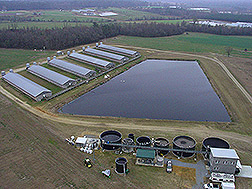|
Read the
magazine
story to find out more. |
|

ARS researchers are
designing ways to turn livestock manure into a value-added bioenergy fuel for
on-farm heating and power. Click the image for more information about
it.
|
|

|
Making the Most of Manure
By Ann Perry
October 1, 2008
Manure from livestock could someday be used as a value-added bioenergy
fuel for on-farm heating and power, according to
Agricultural Research Service (ARS)
scientists studying this approach.
This will be good news to U.S. livestock producers, who need
environmentally friendly ways to manage the manure generated by about 96.7
million cattle and 67.7 million hogs and pigs.
ARS agricultural engineer
Keri
Cantrell, environmental engineer
Kyoung
Ro, and research leader
Patrick
Hunt work at the ARS
Coastal
Plains Soil, Water and Plant Research Center in Florence, S.C. They have
teamed up to study how to use a technique called wet gasification to convert
wet manure slurry into energy-rich gases and produce relatively clean water.
The team developed a cost-benefit model of a wet gasification
technology patented by the U.S. Department of
Energy (DOE) to calculate estimated returns, and concluded that liquid
swine wastes can generate a net energy potential comparable to brown coal.
The ARS researchers are also investigating methods for producing a
type of charcoal—or biochar—called “green coal” from
manure. Green coal can be burned on the farm for energy or transported offsite
to coal plants for fuel. It can also be added to the soil, a practice that
would reduce greenhouse gases by permanently sequestering carbon in the soil in
the form of the green coal.
In addition, the scientists are collaborating with the Advanced Fuels
Group at the DOE Brookhaven National
Laboratory in New York. They are evaluating different catalysts needed to
facilitate the conversion of “syngas,” the gas that is produced when
animal wastes (and other biomass) are gasified, to liquid fuels.
The Florence scientists want to develop new waste treatment methods
and strategies that could be used by almost any farm—from a small family
business to a large-scale concentrated animal production facility—to meet
all their energy needs.
Read more
about this research in the October 2008 issue of Agricultural Research
magazine.
ARS is a scientific research agency of the
U.S. Department of Agriculture.